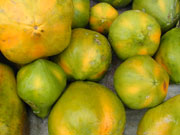 |
 |
|
Papaya |
|
There is a riddle in the famous movie - "Liu San
Jie". It says: "what kind of fruit grows on the neck of the tree?" The answer is papaya. Papaya has many other names and it is a kind of large-sized herbal plant. The herb is soft and can grow as tall as 10 meters. Papaya leaves look like palms, which are big and thick; and they grow on the long and tube-like stalks of the plant. Female papaya plants and male papaya plants grow separately; the papaya flowers are white or yellow, which give off strong aromas; the fructifying period of papaya is from April to November each year, and the papaya fruits grow on tops of the papaya plants. Papaya fruits are numerous in number and elliptical in shape, and they can grow to as heavy as several kilograms. When the fruits are living, they are green; and they turn to yellow when they are ripe. The fruit pulp is golden yellow, fine, and soft, quite like that of mango; but it has no sour flavors, thus, is loved by many.
 |
|
Flowers of Papaya |
Papaya originates from South Mexico and Mid-America. It scatters in all tropical and sub-tropical districts of the world today. After papaya was introduced into China, many provinces in China, such as Taiwan, Fujian, Canton, Hainan, Guangxi and Yunnan, began to plant it. As for the time when papaya was introduced into China, there are two different sayings. One saying goes: there were some records in the "Miscellanies of South China" , and the book was written in the end of the 17th century, and thus, it proved that the plantation history of papaya in China had a history of more than 300 years. Another saying goes: in Wang Dang's book named "Tang Yu Lin", there were also records about papaya; and the book was written based on the materials of the Tang Dynasty by the end of the Song Dynasty; therefore, some people believe that the introduction of papaya into China occurred at least in the 12th century. In the book, there was also a story about the introduction of papaya into China. There was a Chief in Huzhou. When he was going to see his friend off, someone sent him a papaya; but, no one saw any papaya before among his friends, so they passed the papaya around and had a look each; a eunuch was also among the people and he hid the papaya away; according to him, if no one had ever seen such a fruit, it should be donated to the emperor first. The eunuch went back to the capital city soon. The Chief was quite annoying because of this, because he was afraid that the emperor would charge him after the eunuch went back. But, at that time, a dancing girl told him that he had no need to worry about this, because she believed that the eunuch would throw the papaya into the river the next evening. Soon, the people who sent the eunuch away came back and reported that the papaya was rankled the next day and was thrown away by the eunuch. At this, the Chief appreciated the dancing girl's knowledge very much. After careful inquiries, he got to know that it was very difficult to keep papaya fresh for long time; particularly when a ripe papaya was touched by many people, it would be particularly difficult to do this.
 |
|
Papaya |
Papaya fruits can not only be used as fruits or a vegetable, they can also be used as medicines. The juice of living papaya can be used to extract a kind of high-rank material for making cosmetics, which has the effect of beautifying. In the same time, the substance also has strong effect for dissolving proteins, and thus can be used to make medicines for tonifying the stomach and material for making insecticides. Besides, it can also be used as the clarifying agent and softening agent of wines and fruit juices. It's said that, when the Americans cook beef, they like to inject the same substance into the beef; in this way, the beef becomes ripe more quickly and also become tender, which makes it easier for digestion. The natives of tropical Australia often use the green leaves of the papaya plant to wrap meats before the meats are cooked, or they may cook the meats with the leaves together, because the meat will become softer in this way. In Xishuangbanna, half ripe papaya is often used as a vegetable. They have two cooking methods for cooking papaya. One way is, they will use it to cook soup, which has a faint sweetness and is quite delicious; the other method is to cut the papaya fruit into thin chips and mix the chips with vinegar, sauce and pepper powder; in this way, they can get a cold dish. Ripe papaya fruits are high-rank and rare fruits, they contain large amount of protein, vitamin C, and carotin etc. They can be eaten in fresh, and can also be made into drinks, syrupy juice, ice creams, and syrups etc. The protein enzyme in papaya has the effects of healing indigestion, high blood pressure, arthritis, and biting of insects etc. Therefore, ripe papaya fruit is a kind of ideal fruit after meals. As early as in the 15th century, Columbus found that the natives of the Caribbean Seas often eat some papaya fruits after eating too much fish or meat to prevent indigestion. Besides, some people of today also use the ripe papaya pulp as the agent for making shampoos or medicines.

|